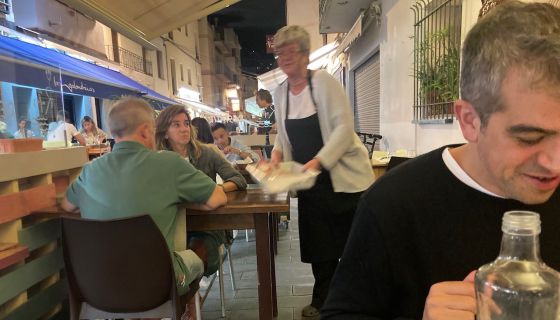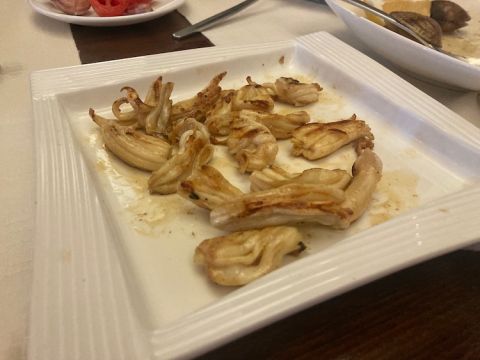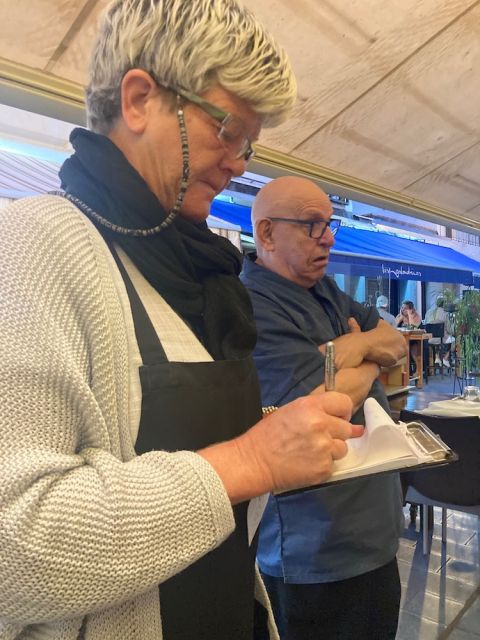Our dinner at Rafa’s on the Carrer de Sant Sebastià, pictured above with our Ferran on the right, otherwise known as Restaurant Row, in the heart of Roses on the Costa Brava was as good as my first meal there nine years ago.
In fact very little had changed. Rafa Cantero spent most of the evening in his open kitchen, grilling a range of fish to perfection: a plate of sea cucumbers; a dish of mussels; a thin slice of negrito, white tuna; and best of all a whole John Dory, of which the skin was crisp and the flesh came away from the bone easily. (With two bottles of wine, the bill for the four of us came to €290).
Rafa looked the same, having survived the past two years and a bout of cancer; his smile was as welcoming as ever. So too was that of Rosa Riera, his long-standing waitress and order-taker who also makes a speciality of loading a plastic container with the fresh fish that are available and bringing this less-than-distinguished container to your table for you to choose from (they were married but now they just work together). She still bustles around the restaurant wrapped in a cardigan although it was at least 28 °C, even away from the grill!
Such cooking of fish is not confined to this restaurant or even this city. Similar places seem to exist in most cities and towns where fish is caught close by to any extent: in Spain, in Portugal, up and down the west coast of the US, in Italy and in Croatia, in Japan, in Australia and New Zealand, in Scotland, and along the south-west coast of England. Anywhere where the sea is in close proximity to a discerning population. In fact, it is this combination that has made the reputation of Rick Stein of Padstow, Cornwall.
And yet there is no one brand-name that provides a uniting factor. Perhaps Nobu is the closest to this, with just over 50 restaurants worldwide since he first opened his second restaurant in New York in 1994. But the techniques used at Nobu are more rarified. How many of us even know how to choose the best fish for sushi, let alone slice and prepare it?
But some of the best-known fish restaurants in the world are some of the oldest. In London, J Sheekey opened in the 1890s when Josef Sheekey was given permission by Lord Salisbury to serve fish and shellfish in St Martin’s Court in theatre-land. Bentley’s served its first oyster in 1916 while Scott’s can trace its opening back to 1851 when John Scott set up his oyster warehouse first of all on the Haymarket. (Scott’s, now in Mayfair, is set to open its second location in Richmond at the end of this month).
Oysters are obviously the common denominator here. Once so plentiful, oysters seem to have provided the perfect inexpensive introduction to the serving of far more expensive fish. Today, a portion of fresh fish is as expensive as any cut of good-quality meat.
I put the question as to why, although certain fish restaurants may have a longer history, they have not multiplied, to Will Beckett, the co-founder of the Hawksmoor steak restaurants that now number nine in the UK and one in the US. Beckett is also chairman of the Rockfish group of nine excellent fish restaurants around the south-west of England founded by his friend Mitch Tonks. He replied immediately with several thoughts by email.
‘Firstly’, he said, ‘because there are fewer of them, there has been less competition which has led those that have survived to become institutions. Apparently, there is an expression “fish ain’t got no legs”. Those that have survived have done so by appealing to an older demographic who are less partial to trends and fads.’
He countered my list by saying that the restaurants I mentioned are also all high-end and expensive. He then asked me, hypothetically, whether these restaurants would have survived if they had not been, adding that Tonks would say yes, as long as these restaurants were by the sea.
And then he continued by mentioning the longevity of meat-oriented restaurants such as Peter Luger, Simpson’s in the Strand and Sam’s Chop House in Manchester and our son’s Quality Chop House in London, a comment I accepted up to a point. Peter Luger, of which there are only two, only really got under way in 1950. Simpson’s is the oldest, having opened in 1828 as a chess club, and the chop houses are almost as old, the Manchester one having opened its doors in 1868 and the London one in 1869. (These two are unrelated other than by name.)
It was now time to ask Tonks himself, the man who now controls quite a fish empire in the south-west of England. In addition to the Rockfish restaurants and the Seahorse in Dartmouth, Tonks also has an interest in fishing boats as well as a fish delivery business.
‘My theory on fish restaurants is that if I think about Sheekey’s, Bentley’s and Scott’s they all have a distinctive warm feel about them. But most of all I think customers value fish restaurants more. They are special places that have a certain trust in one’s mind, born from the fact that people who eat fish are seeking the rare pleasure of fresh seafood, especially in a city. Once discovered, they also remain extremely loyal and visits become almost celebratory.’
When I asked him about the proliferation of Nobu restaurants around the world, he countered, ‘With Nobu, I just think that the cooking there has been way ahead for a number of years and introduced us to Japanese flavours and preparations which are unique. We also know subliminally that the Japanese are sticklers for freshness and in that we trust – we feel we are eating something special.’
When I asked him which, for him, presented the bigger challenge, finding the fish or finding the customers, Tonks was quite frank.
‘For my own restaurants, it’s definitely finding fish.That isn’t to say we are running out, but there is just more competition for the seafood landed here in Brixham. We now have an interest in a boat and we land catches directly from small bass and lobster fishermen taking all the catch at a higher price which works for both of us in terms of stability. We also get our hands on the freshest seafood which our guests come searching for – they trust, and expect us, to do so and therein lies the reason why fish restaurants last – because of the trust in knowing they will eat good seafood. On the flip side a poor seafood restaurant has probably the shortest lifespan of any restaurant.’
If that is the case, then perhaps I had started this investigation the wrong way round. Instead of asking why there has not been a proliferation of great seafood restaurants following in the wake of J Sheekey, Bentley’s and Scott’s, I should have asked: why don’t we give more attention to chefs and restaurateurs such as Cantero, Tonks, John Macleod at the two Crabshakk restaurants in Glasgow, Josh Niland at Saint Peter in Sydney, and Luca di Vita and Bruno Gavagnin at Alle Testiere in Venice. They, and their numerous peers, are the ones who from early in the morning until late at night ensure that there is enough fish, of high enough quality, to feed us and therefore provide an extra reason for visiting their respective cities.
Rafa’s Carrer de Sant Sebastià 56, 17480 Roses, Spain; tel: +34 972 25 40 03















